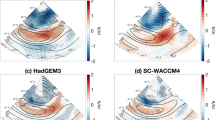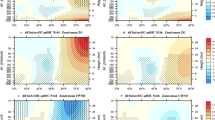Abstract
This work examines the near-surface responses, in the Southern Hemisphere atmosphere, to a reduction and an excess of sea ice cover in the Ross Sea. Large ensembles (60 members) of the Atmospheric General Circulation Model of the Center for Weather Forecast and Climate Studies (AGCM-CPTEC) are used for this purpose. Locally, when the sea ice cover decreases (increases), heat fluxes, temperature, and pressure increase (decreases). A principal component analysis of temperature and geopotential height identifies the potential remote connections. We have found three main results: first, an association between the sea ice cover in the Ross Sea and a wave train that resembles the Pacific South American (PSA) pattern; second, a relationship between temperatures in the Ross Sea and in the southern South America; and third, an apparent correspondence between reduced sea ice cover in the Ross Sea and the subtropical jet over Australia.














Similar content being viewed by others
References
Alexander MA, Bhatt US, Walsh JE, Timlin MS, Miller JS, Scott JD (2004) The atmospheric response to realistic Arctic sea ice anomalies in an AGCM during winter. J Climate 17:890–905
Ambrizzi T, Hoskins BJ, Hsu H-H (1995) Rossby wave propagation and teleconnection patterns in the austral winter. J Atmos Sci 52:3661–3672
Berbery EH, Nogués-Paegle J, Horel JD (1992) Wavelike Southern Hemisphere extratropical teleconnections. J Atmos Sci 49:155–177
Budillon G, Fusco G, Spezie G (2000) A study of surface heat fluxes in the Ross Sea (Antarctica). Antarct Sci 12:243–254
Cavalcanti IFA et al (2002) Global climatological features in a simulation using the CPTEC-COLA AGCM. J Climate 15:2965–2988
Cavalcanti IFA, Kayano MT (1999) High-frequency patterns of the atmospheric circulation over the Southern Hemisphere and South America. Meteorol Atmos Phys 69:179–193
Cavalieri DJ, Parkinson CL (2008) Antarctic sea ice variability and trends, 1979–2006. J Geophys Res 113:C07004
Cavalieri D, Parkinson C, Gloersen P, Zwally HJ (1996, updated 2008) Sea ice concentrations from Nimbus-7 SMMR and DMSP SSM/I passive microwave data, 1979–2005. Boulder, Colorado USA: National Snow and Ice Data Center. Digital media
Deser C et al (2004) The effects of North Atlantic SST and sea ice anomalies on the winter circulation in CCM3. Part II: direct and indirect components of the response. J Climate 17:877–889
Garreaud RD (2000) Cold air incursions over subtropical South America: mean structure and dynamics. Mon Weather Rev 28:2544–2559
Garreaud RD, Battisti DS (1999) Interannual (ENSO) and interdecadal (ENSO-like) variability in the Southern Hemisphere tropospheric circulation. J Climate 12:2113–2123
Gong D, Wang S (1999) Definition of Antarctic oscillation index. Geophys Res Lett 26:459–462
Hannachi A, Jolliffe IT, Stephenson DB (2007) Empirical orthogonal functions and related techniques in atmospheric science: a review. Int J Climatol 27:1119–1152
Herman GF, Johnson WT (1978) The sensitivity of the general circulation to Arctic sea ice boundaries: a numerical experiment. Mon Weather Rev 106:1649–1664
Honda M et al (1999) Dynamic and thermodynamic characteristics of atmospheric response to anomalous sea-ice extent in the sea of Okhotsk. J Climate 12:3347–3358
Hudson DA, Hewitson BC (2001) The atmospheric response to a reduction in summer Antarctic sea-ice extent. Clim Res 16:79–99
Hurrel JW, van Loon H, Shea, DJ (1998) The mean state of the troposphere. In: Karoly D, Vincent DG (ed) Meteorology of the Southern Hemisphere, 1st edn. American Meteorological Society, Boston
Kaiser HF (1958) The varimax criterion for analytic rotation in factor analysis. Psychometrika 23:187–200
Karoly DJ (1989) Southern Hemisphere circulation features associated with El Niño–Southern Oscillation events. J Climate 2:1239–1252
Kidson JW (1999) Principal modes of Southern Hemisphere low-frequency variability obtained from NCEP–NCAR reanalyses. J Climate 12:2808–2830
Kiladis GN, Mo KC (1998) Interannual and intraseasonal variability in the Southern Hemisphere. Karoly DJ, Vincent DG (eds) Meteorology of the Southern Hemisphere, 1st edn. American Meteorological Society, Boston, pp 307–336
Kinter JL et al (1997) The COLA atmosphere–biosphere general circulation model. Vol. 1: formulation. COLA. Calverton, MD, s.n., p 46, Rep. 51
Kushnir Y, Robinson WA, Bladé I, Hall NMJ, Peng S, Sutton R (2002) Atmospheric GCM response to extratropical SST anomalies: synthesis and evaluation. J Climate 15:2233–2256
Lachlan-Cope T (2005) Role of sea ice in forcing the winter climate of Antarctica in a global climate model. J Geophys Res 110:D03110
Lachlan-Cope T, Connolley W (2006) Teleconnections between the tropical Pacific and the Amundsen–Bellingshausen Sea: role of the El Niño/Southern Oscillation. J Geophys Res 111:D23101
Lau NC (1981) A diagnostic study of recurrent meteorological anomalies appearing in a 15-year simulation with a GFDL general circulation model. Mon Weather Rev 109:2287–2311
Lemke P, Trinkl EW, Hasselmann K (1980) Stochastic dynamic analysis of polar sea-ice variability. J Phys Oceanogr 10:2100–2120
Magnusdottir G, Deser C, Saravanan R (2004) The effects of North Atlantic SST and sea ice anomalies on the winter circulation in CCM3. Part I: main features and storm track characteristics of the response. J Climate 17:857–876
Mitchell JFB, Hills TS (1986) Sea-ice and the Antarctic winter circulation: a numerical experiment. Quart J R Met Soc 112:953–969
Mo K, Ghil M (1987) Statistics and dynamics of persistent anomalies. J Atmos Sci 44:877–901
Mo KC, Higgins RW (1998) The Pacific–South American modes and tropical convection during the Southern Hemisphere winter. Mon Weather Rev 126:1581–1596
Mo KC, Paegle JN (2001) The Pacific–South American modes and their downstream effects. Int J Climatol 21:1211–1229
Mo KC, White GH (1985) Teleconnections in the Southern Hemisphere. Mon Weather Rev 113:22–37
Peng S, Robinson WA (2001) Relationships between atmospheric internal variability and the responses to an extratropical SST anomaly. J Climate 14:2943–2959
Peng S, Whitaker JS (1999) Mechanisms determining the atmospheric response to midlatitude SST anomalies. J Climate 12:1393–1408
Plumb RA (1985) On the three-dimensional propagation of stationary waves. J Atmos Sci 42:217–229
Quintanar AI, Mechoso CR (1995) Quasi-stationary waves in the Southern Hemisphere. Part I: observational data. J Climate 8:2659–2672
Raphael M (2001) Response of the large-scale, Southern Hemisphere extratropical atmospheric circulation to extremes of Antarctic sea-ice concentration in a general circulation model. Polar Geogr 25:(3)218–238
Richman MB (1986) Rotation of principal components. J Climate 6:293–335
Scientific Committee on Antarctic Research (2009) Antarctic climate change and the environment. The International Council for Science. Victoire, Cambridge, p 526 (a contribution to the International Polar Year 2007–2008. 978-0-948277-22-1)
Simmonds I, Budd WF (1991) Sensitivity of the Southern Hemisphere circulation to leads in the Antarctic pack ice. Quar J Roy Meteor Soc 117:1003–1024
Simmonds I, Jacka TH (1995) Relationships between the interannual variability of Antarctic Sea ice and the Southern Oscillation. J Climate 8:637–647
Simmonds I, Keay K, Lim E-P (2003) Synoptic activity in the seas around Antarctica. Mon Weather Rev 131:272–288
Simmons AJ, Wallace JM, Branstator GW (1983) Barotropic wave propagation and instability, and atmospheric teleconnections patterns. J Atmos Sci 40:1363–1392
Taylor KE, Williamson D, Zwiers F (2000) The sea surface temperature and sea ice concentration boundary conditions for AMIP II simulations. Program for climate model diagnosis and intercomparison. Lawrence Livermore National Laboratory, Livermore, s.n., 2000, p. 25, PCMDI report 60
Thompson DW, Wallace JM (2000) Annular modes in the extratropical circulation. Part I: month-to-month variability. J Climate 13:1000–1016
Trenberth K (1979) Interannual variability of the 500 mb zonal mean flow in the Southern Hemisphere. Mon Weather Rev 107:1515–1524
Trenberth K (1980) Planetary waves at 500 mb in the Southern Hemisphere. Mon Weather Rev 108:1378–1389
Trenberth KE (1991) Storm Tracks in the Southern Hemisphere. J Atmos Sci 48:2159–2178
Uppala SM et al (2005) The ERA-40 re-analysis. Quart J Roy Meteor Soc 131:2961–3012
von Storch H, Zwiers FW (1999) Statistical analysis in climate research. Cambridge University Press, Cambridge
Wilks DS (2006) Statistical methods in the atmospheric sciences. Academic, Amsterdam
Yuan X (2004) ENSO-related impacts on Antarctic sea ice: a synthesis of phenomenon and mechanisms. Antarct Sci 16:415–425
Yuan X, Martinson DG (2000) Antarctic Sea ice extent variability and its global connectivity. J Climate 13:1697–1717
Yuan X, Martinson DG (2001) The Antarctic Dipole and its predictability. Geophys Res Lett 28:3609–3612
Acknowledgments
The first author is grateful to Dr. Caio Coelho and Dr. Manoel Cardoso for the valuable comments and advices given in earlier versions of this manuscript. We also appreciate the constructive comments given by the anonymous reviewer. We are grateful to the National Snow and Ice Data Center (NSIDC) and Sea Ice Remote Sensing Group (NASA) for keeping and providing the data. This paper is part of the Ph.D. thesis of the first author. The high-resolution ERA-40 data set used in this study has been provided by ECMWF to CPTEC/INPE.
Author information
Authors and Affiliations
Corresponding author
Rights and permissions
About this article
Cite this article
Cunningham, C.A., Bonatti, J.P. Local and remote responses to opposite Ross Sea ice anomalies: a numerical experiment with the CPTEC/INPE AGCM. Theor Appl Climatol 106, 23–44 (2011). https://doi.org/10.1007/s00704-011-0407-y
Received:
Accepted:
Published:
Issue Date:
DOI: https://doi.org/10.1007/s00704-011-0407-y




